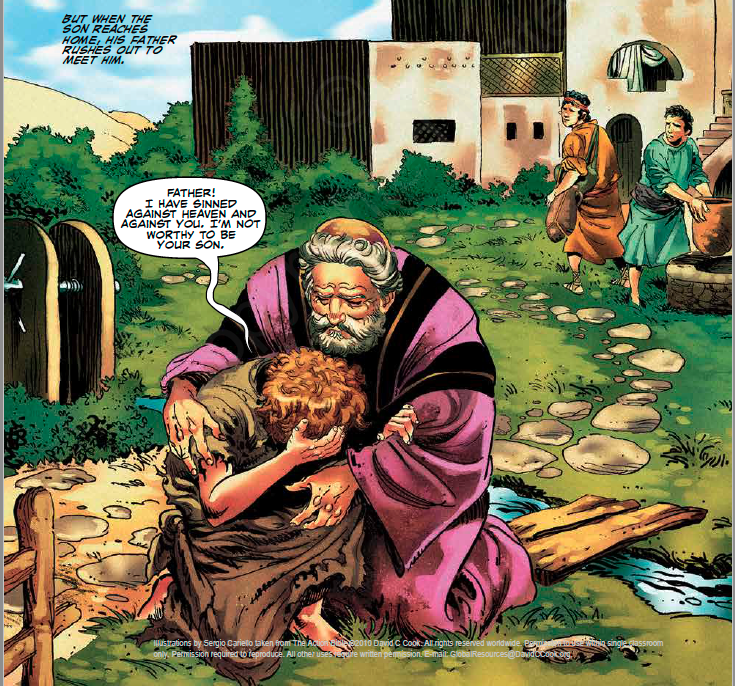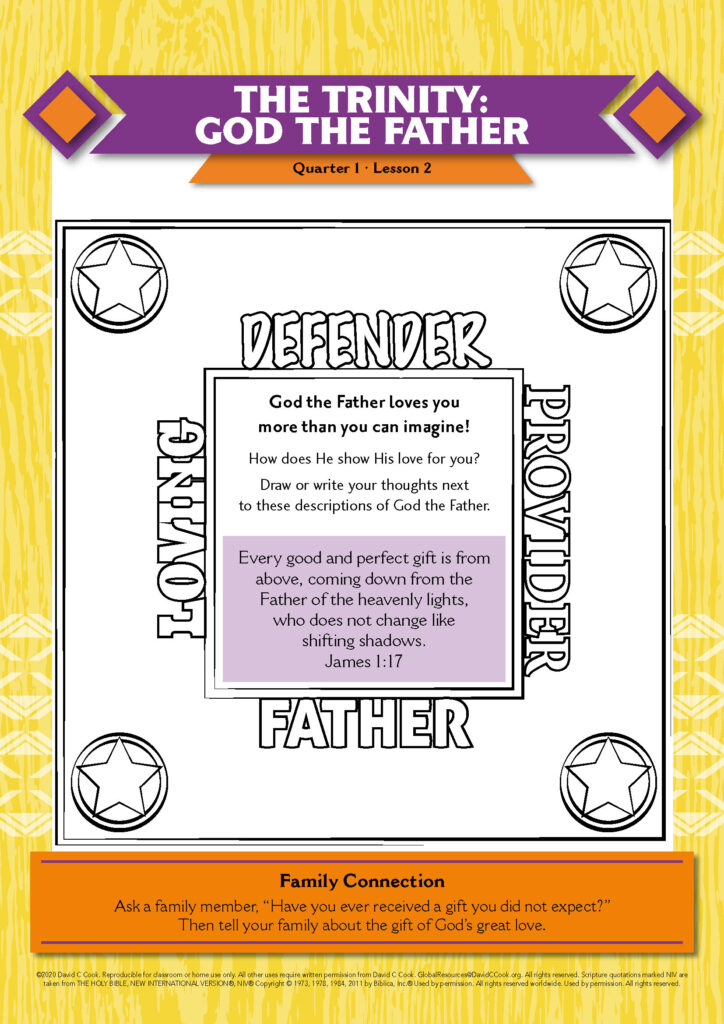During the lesson, the information for you to know is written in regular type, and what we suggest speaking or reading aloud to children is in bold. All resources for this lesson, including the Teacher Guide, Student Page, Family Connection Card, and other resources can be downloaded in a ZIP file by clicking on the following link:
In some lessons you will find "resource articles." These are articles written by experts from around the world to help equip you for your work with children and adolescents. Share them with parents or guardians if you consider it appropriate.
There is but one God, the Father, from whom all things came and for whom we live.
1 Corinthians 8:6
What do you think of when you think of God the Father? An all-wise ruler? A judge? A loving father? Your idea of God is likely influenced by your life experiences, Scripture, and feelings about your earthly father.
As you prepare to teach this lesson about God the Father, think of all of the things you know are true about Him. Which characteristics of God the Father are most meaningful to you today? Think about your list and take time to praise God for who He is. Ask Him to reveal Himself to your students through this lesson—particularly as their perfect, loving Father.
Regardless of whether or not your students have had good earthly fathers, their Father in heaven will always love and stand beside them. He created them and loves them fully. He wants to provide for them, protect them, defend them, and, at times, even discipline them for their good and His glory. Pray that He will help you and your students to connect with Him as Father God in a personal way and show all of you that He is worth living for.
Encourage the students to ask their family members, “Have you ever received a gift you did not expect?” The students can then share about the gift of God’s great love.
Teacher Tip: If possible, email or text the Family Connection Card to the families of your students.
Today you will continue teaching your students about one God who is three Persons by focusing on God the Father. Welcome your students as they enter class today and ask them to talk with 1–2 others about the following questions. After all your students have arrived, ask the questions of the whole group and allow students to share their thoughts.
Tell the students to think for a few seconds before they answer.
Optional: Before class, write the word “God” on a large piece of paper. Hang it up on the wall. Give each student a marker or pencil. Invite students to write or draw something they think of when they think about God. You can use the questions listed here to help them.
Make sure that you or 1 of the students mentions the word “Father.” After the students have had time to offer their ideas, take some time as a group to discuss some of ideas presented. Do not correct any ideas they offer at this time. They will learn more about who God is as you go through this lesson.
God is amazing. We could spend our whole lives learning about Him and still only know a little bit of who He is. Today we are going to talk about God the Father. As we learned in our last lesson, there is only one God, but He is three Persons.
Students may answer that God the Father loves us completely. Jesus, God’s Son, became one of us so He could pay for our wrongs. When we go through tough times, He understands what it is like, because He suffered as a human being, too. And the Holy Spirit is God living inside of Christians, reminding us of God’s truth and guiding us to do good things.
Today we will talk about the first Person of the Trinity—God the Father.
Some may not have fathers. Some may have fathers who are abusive or absent. In this lesson, we will describe a heavenly Father who is different from the earthly fathers they may have experienced.
Allow the entire class to act out the parable from Luke. You will need the following actors: father, 2 sons, 2–3 friends, and 2–3 pigs. The other students can be servants and other people at the celebration. Have your actors act as you read the story. You may also want to direct their actions as you read. Read the story from Luke 15:11–24—or ask a good reader to read it—as the students act it out.
Optional: You may provide some optional costumes and props, such as coins or pebbles (to serve as coins), a suitcase or bag, a bucket, and a robe or garment. If you do not have the optional supplies, students can pretend to have these items.
There was a man who had 2 sons (father and 2 sons enter). The younger son said to his father, “Father, give me the share of the estate that will be mine when you die.” So the father divided his property between his sons. (Father may pass out some money or pebbles, or he can simply gesture in 2 directions.)
Not long after that, the younger son packed his belongings (younger son picks up suitcase or bag), set off for a distant country, and there wasted his money in wild living. (Friends enter, and son gives them coins or pebbles. They all act like they are having a party.)
After he had spent all his money, there was a severe famine in the whole country, and the son had no money, no food, and no friends (friends leave, and son drops to knees with nothing left). So he found a job feeding pigs (son picks up bucket and pretends to feed pigs). He longed to fill his stomach with the pods the pigs were eating, but no one gave him anything (son motions to indicate hunger).
When he came to his senses, he said, “How many of my father’s hired servants have food to spare, and here I am starving to death! I will set out and go back to my father and say to him, ‘Father, I have sinned against heaven and against you. I am no longer worthy to be called your son; treat me like one of your hired servants.’”
So he got up and went to his father (son begins walking home). But while he was still a long way off, his father saw him and was filled with compassion for him (father looks for his son and then sees him); he ran to his son, threw his arms around him, and kissed him (father hugs and welcomes son). The son said to him, “Father, I have sinned against heaven and against you. I am no longer worthy to be called your son.”
But the father said to his servants, “Quick! Bring the best robe and put it on him. Put a ring on his finger and sandals on his feet (servants put robe on son). Bring the fattened calf and kill it. Let’s have a feast and celebrate. For this son of mine was dead and is alive again; he was lost and is found.” So they began to celebrate (all celebrate).

Have everyone clap for each other and sit down.
The son disrespected the father and wasted all of his money.
Jesus often told stories called parables. They are stories that teach truths or lessons. Jesus told this story to help people understand what His Father in heaven is like. Even though the son in the story did some very wrong things, his father still loved him and wanted him to return home. He even threw a big celebration party when his son returned!
Each of us has an earthly father. Some of us have good fathers. Others of us have fathers who have hurt us emotionally or physically. Some of us may have never even met our fathers or do not remember them. How you feel about your earthly father can affect how you view your heavenly Father.
Regardless of what your earthly father is like, God is the perfect Father. He loves you fully and will never leave you. He knows everything about you and has a wonderful plan for your life. Best of all, like the father in the story, He loves you no matter what you have done and welcomes you with open arms. To become His child, you only have to accept the free gift He offers you of forgiveness of your sins through Jesus’ sacrifice on the cross.
Let’s spend a few minutes learning more about our heavenly Father. I will read several verses about God the Father, and then we will talk about them.
If possible have 1 or more of your students read the following verses aloud from the Bible. After reading each verse, ask the questions below. Students can share their answers aloud.
Optional: You may write these verses and the students’ responses on a large piece of paper or a whiteboard.
A father to the fatherless, a defender of widows, is God in his holy dwelling.
Psalm 68:5
Possible answers include protector, one who cares, defender, and provider.
Look at the birds of the air; they do not sow or reap or store away in barns, and yet your heavenly Father feeds them. Are you not much more valuable than they?
Matthew 6:26
Possible answers include provider, giver, and similar thoughts.
Every good and perfect gift is from above, coming down from the Father of the heavenly lights, who does not change like shifting shadows.
James 1:17

Possible answers include giver, provider, steadfast, and never changing.
The Lord disciplines those he loves, as a father the son he delights in.
Proverbs 3:12
Possible answers include loving, defender, and discipliner.
Invite students to work together to create a picture about God’s many characteristics. You may use sticks to draw in the sand or dirt and decorate the picture with other natural supplies.
Optional: Give the students paper and colored pencils, or markers, and ask them to create pictures of God’s characteristics.
If you are using the Student Pages, have the students draw their pictures on these pages.

At the beginning of our time today, we shared our ideas about God. Now that we have learned more about our heavenly Father, we will create a picture that shows the aspects of God the Father that are the most meaningful to you. You can include words or simply draw a picture.
Remember the verses we read last time about God’s invitation to become part of His family? We will read 1 of those verses again.
Yet to all who did receive him, to those who believed in his name, he gave the right to become children of God.
John 1:12
As the students draw, ask them these questions. More than 1 student can answer each question:
Give the students some time to draw what they are feeling. If you see a student who is not participating, encourage him to draw even something small, such as a heart or a shield, to represent God’s love or protection for us. When most have completed their drawings, take some time to talk about what they have drawn or written. In some cases, these may be private feelings they prefer not to talk about. Do not force them.
Optional: If you used the optional activity with the large sheet of paper at the beginning, have the students tape their pieces of artwork over the large sheet of paper to show their new understanding of God as their Father.
Pray, affirming your love for and trust in your heavenly Father. When you are ready to end class, let students know you are available if they want to talk about how to become a child of God. Close your time with a blessing over your students based on Ephesians 4:6.
Blessing: May you rest in being the loved child of your heavenly Father. And may the one God and Father of all, who is over all and through all and in all, be with you today and always.
Life on Life ©2020 David C Cook. Reproducible for home or classroom use only. All other uses require written permission from David C Cook [email protected]. All rights reserved.